Monthly Archives: October 2023

 My little great grandson, Justin Petersen, who is the son of my grandson, Josh Petersen and his wife Athena Petersen, has had an eventful first year of life. When he was about a month old, Justin got the flu, which can be very scary for a baby. He spent some time in the hospital, and the doctors thought it might be tough and go, but with much prayer, he came out of it, and proceeded to flourish, and have great health. Nevertheless, that was a time none of us ever want to go through again.
My little great grandson, Justin Petersen, who is the son of my grandson, Josh Petersen and his wife Athena Petersen, has had an eventful first year of life. When he was about a month old, Justin got the flu, which can be very scary for a baby. He spent some time in the hospital, and the doctors thought it might be tough and go, but with much prayer, he came out of it, and proceeded to flourish, and have great health. Nevertheless, that was a time none of us ever want to go through again.
These days, Justin has a new job. He is a big brother. His baby brother, Axel was born 26 days before Justin turned 1 year old. That makes these brothers Irish Twins. Of course, they don’t know what that means yet, but they will eventually. Axel just knows that he’s tired, hungry, or wet. Justin just knows that there is a new baby at his house, and he really loves him. He doesn’t know it yet, but that new baby is going to 
 one of his best friends. Justin has a new built-in playmate. They will most likely fight over things like toys, space, and the last candy bar, among other things. Nevertheless, they will also learn that when it comes right down to it, brothers stick together. It will be a matter of knowing that “you might pick on your brother, but nobody else better do so.” That is sort of the sibling code. Siblings have to stick together!!
one of his best friends. Justin has a new built-in playmate. They will most likely fight over things like toys, space, and the last candy bar, among other things. Nevertheless, they will also learn that when it comes right down to it, brothers stick together. It will be a matter of knowing that “you might pick on your brother, but nobody else better do so.” That is sort of the sibling code. Siblings have to stick together!!
Justin was just beginning to take his early steps when his brother arrived, and now he is getting to be an old hand at it. I’m sure he realized that his mommy and daddy were going to have to be carrying his little brother around a lot, so he might have to walk on his own two feet. Not really, of course, because one-year-old-boys don’t think that way. Nevertheless, Justin knows that things have changed in his world, and he couldn’t be happier about it. Justin has always been a happy little boy, but he also has a “thinking” side to him too. I see it in him. He is a concentrator. I know it, 
 because I am a concentrator. We think things through, and sometimes people even think we are angry, because we tend to frown when we concentrate. Still, Justin has a goofy side too. He loves his toys and exploring new places. And Justin loves his Papa, my son-in-law, Kevin Petersen and Grandma, my daughter, Corrie Petersen. Still, his daddy is Justin’s fav!! Whenever he is at my house, and he finds out that his daddy is coming to pick him up, he stands at the door watching for him, and when he arrives…look out, because his daddy “hung the moon” and that’s a fact. Today is Justin’s first birthday. Happy birthday Justin!! Have a great day!! We love you!!
because I am a concentrator. We think things through, and sometimes people even think we are angry, because we tend to frown when we concentrate. Still, Justin has a goofy side too. He loves his toys and exploring new places. And Justin loves his Papa, my son-in-law, Kevin Petersen and Grandma, my daughter, Corrie Petersen. Still, his daddy is Justin’s fav!! Whenever he is at my house, and he finds out that his daddy is coming to pick him up, he stands at the door watching for him, and when he arrives…look out, because his daddy “hung the moon” and that’s a fact. Today is Justin’s first birthday. Happy birthday Justin!! Have a great day!! We love you!!

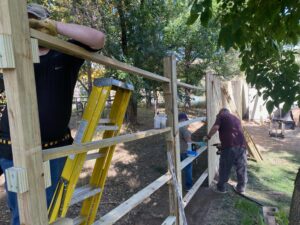 When my brother-in-law, Mike Stevens retired on July 1, 2022, our nephew, Ryan Hadlock, who had worked with his uncle for quite some time at Contango Energy, was promoted to the position. Ryan hadn’t been groomed for the new position, but they saw something in him…the ability to excel. Now, over a year later, Ryan is doing great at his job. He really enjoys the work, is well respected, and always received high praise from his bosses. Ryan knew the work that the men under him were to do, because that was the work he had done, but knowing the job, isn’t what makes him good at being a supervisor. That is something that not everyone can do, but Ryan is quite good at it.
When my brother-in-law, Mike Stevens retired on July 1, 2022, our nephew, Ryan Hadlock, who had worked with his uncle for quite some time at Contango Energy, was promoted to the position. Ryan hadn’t been groomed for the new position, but they saw something in him…the ability to excel. Now, over a year later, Ryan is doing great at his job. He really enjoys the work, is well respected, and always received high praise from his bosses. Ryan knew the work that the men under him were to do, because that was the work he had done, but knowing the job, isn’t what makes him good at being a supervisor. That is something that not everyone can do, but Ryan is quite good at it.
Ryan is quite handy in many ways. He and his wife, Chelsea recently helped his parents, Chris and Allyn Hadlock replace an old fence on their property. They did a great job, and now that fence will stand strong for a number of years to come. Fencing is hard work, but Ryan is no stranger to hard work, and he really loved helping his parents. Ryan likes working with his hands. This past summer, he and Chelsea rebuilt the retaining  wall at their house. Chelsea was quite impressed with Ryan’s abilities on the jackhammer, that he used to get the old wall out. I’ve never used a jackhammer, but I’ve heard that the person using it had better be pretty strong, because it’s quite the job.
wall at their house. Chelsea was quite impressed with Ryan’s abilities on the jackhammer, that he used to get the old wall out. I’ve never used a jackhammer, but I’ve heard that the person using it had better be pretty strong, because it’s quite the job.
Like his dad, Ryan could be an expert carpenter, but recently, Ryan has found that he is interested in watches, and the repair thereof. For anyone who has ever seen the inside of a watch, you know that there are about a zillion very small pieces in there, and if everything isn’t put back together just right, the watch will not work, so watch repair is another very impressive thing that Ryan can add to his list of capabilities.
Ryan and Chelsea are a part of a “football family” which comes stands to reason, when on person in the family is a coach of a college football team. That said, they go to quite a few of the Wyoming Cowboys football games. What is not quite so common is for them to attend the away games. This Saturday, that is going to change, however, because they will be heading to Colorado Springs for the Air Force vs Wyoming Cowboys game. Since it will be a first for them, I hope that the Cowboys can bring home the win. Of course, I always hope the Cowboys will bring home a win, because the members of this family are Pokes fans all the way.

 Ryan has decided to join the ranks of many men at this time, by growing out and keeping a beard. t is a trend these days, and many of the men I know wear a beard, so while it will be different on Ryan, it will not be that unusual in our family. I know it will look very nice, and I’m sure his family will be subjected to our family’s famous “whisker rub” that was started by my dad, Al Spencer. Ryan is a teaser from way back, so I’m sure he is looking forward to that tradition too. Today is Ryan’s birthday. Happy birthday Ryan!! Have a great day!! We love you!!
Ryan has decided to join the ranks of many men at this time, by growing out and keeping a beard. t is a trend these days, and many of the men I know wear a beard, so while it will be different on Ryan, it will not be that unusual in our family. I know it will look very nice, and I’m sure his family will be subjected to our family’s famous “whisker rub” that was started by my dad, Al Spencer. Ryan is a teaser from way back, so I’m sure he is looking forward to that tradition too. Today is Ryan’s birthday. Happy birthday Ryan!! Have a great day!! We love you!!
 In every army, navy, and air force, there are exceptional soldiers…even among the enemy. During World War II, the German Luftwaffe had an incredible pilot. His name was Erich Rudorffer, and he is credited with shooting down thirteen Soviet aircraft in a single mission on October 11, 1943. In that historic mission while flying an FW-190, Rudorffer downed eight Yak-7s and five Yak-9s of the Soviet Air Force. He eventually shot down 222 enemy aircraft and ended up his combat career flying the Messerschmitt ME-262, the first operational jet fighter.
In every army, navy, and air force, there are exceptional soldiers…even among the enemy. During World War II, the German Luftwaffe had an incredible pilot. His name was Erich Rudorffer, and he is credited with shooting down thirteen Soviet aircraft in a single mission on October 11, 1943. In that historic mission while flying an FW-190, Rudorffer downed eight Yak-7s and five Yak-9s of the Soviet Air Force. He eventually shot down 222 enemy aircraft and ended up his combat career flying the Messerschmitt ME-262, the first operational jet fighter.
Still, it wasn’t just the number of planes he shot down that made him remarkable. It was also the fact that he managed to survive the war despite flying over 1000 missions and being shot down an incredible 16 times. He was even forced to parachute from his stricken fighter planes 9 of those times. Not just a Soviet killer, Rudorffer also shot down 86 aircraft operated by Western Allied air forces. He became a commercial pilot after World War II.
Rudorffer was born on November 1, 1917, in Zwochau, which was a part of the Kingdom of Saxony of the German Empire at that time. Strangely, or maybe not, very little is said or known about his parents. That was typical of the German leadership of that era. They felt like the state, and not the parents should raise the children, because…well, parents had no training in such things. Not that the German leadership did either, but they decided that they knew more than the parents, so they pulled the children from their parents’ homes and put them in boarding schools to “train” them in the German ways. After his graduation from school, Rudorffer received a vocational education as an automobile metalsmith specialized in coachbuilding, which was likely another of the German or “Nazi” way of deciding the course of the lives of the children. He might have stayed a mechanic were it not for World War I. “Rudorffer joined the military service of the Luftwaffe with Flieger-Ersatz-Abteilung 61 (Flier Replacement Unit 61) in Oschatz on April 16, 1936. From September 2 to October 15, 1936, he served with Kampfgeschwader 253 (KG 253—253rd Bomber Wing) and from October16, 1936 to February 24, 1937, he was trained as an aircraft engine mechanic at the Technische Schule Adlershof, the technical school at Adlershof in Berlin. On March 14, 1937, Rudorffer was posted to Kampfgeschwader 153 (KG 153—153rd Bomber Wing), where he served as a mechanic until end October 1938. After that, he was transferred to Flieger-Ersatz-Abteilung 51 (Flier Replacement Unit 51) based at Liegnitz in Silesia, present-day Legnica in Poland, for flight training. Rudorffer was first trained as a bomber pilot and then as a Zerstörer, a heavy fighter or destroyer, pilot. In the winter of 1944 Rudorffer was trained on the ME 262 jet fighter. In February 1945, he was recalled to command I. Gruppe JG 7 “Nowotny” from Major Theodor Weissenberger who replaced Steinhoff as Geschwaderkommodore. Rudorffer claimed 12 victories with the ME 262, to bring his total to 222. His tally 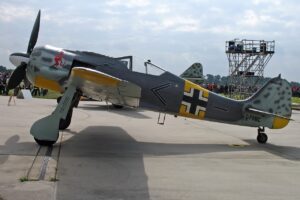 included 136 on the Eastern Front, 26 in North Africa, and 60 on the Western Front including 10 heavy bombers.”
included 136 on the Eastern Front, 26 in North Africa, and 60 on the Western Front including 10 heavy bombers.”
After the war ended, Rudorffer started out flying DC-2s and DC-3s in Australia. Later, he worked for Pan Am and the Luftfahrt-Bundesamt, Germany’s civil aviation authority. Rudorffer was honored as one of the characters in the 2007 Finnish war movie “Tali-Ihantala 1944.” A FW 190 participated, painted in the same markings as Rudorffer’s aircraft in 1944. The aircraft, now based at Omaka Aerodrome in New Zealand, still wears the colors of Rudorffer’s machine. Rudorffer died in April 2016 at the age of 98. At the time of his death, he was the last living recipient of the Knight’s Cross of the Iron Cross with Oak Leaves and Swords.

 My nephew, Riley Birky has changed so much over the years that he has been a part of our family. Riley is the middle child and eldest son of my sister-in-law, Rachel Schulenberg, who sadly passed away in 2021. Riley has grown and changed in the years that I have known him, but I can say that Riley is a soft-hearted man, who is a gentle and loving partner, dad, and brother. His family is so blessed to have him in their lives. Riley and his fiancée, Sierah Martin make their home in Byron, Wyoming. It is a small town, but that’s the way they like it. Riley grew up in Powell, Wyoming, so small town seem to really suit him best, and a small town is the place he wants to raise his family. It provides them with everything they love to do, like fishing and hiking.
My nephew, Riley Birky has changed so much over the years that he has been a part of our family. Riley is the middle child and eldest son of my sister-in-law, Rachel Schulenberg, who sadly passed away in 2021. Riley has grown and changed in the years that I have known him, but I can say that Riley is a soft-hearted man, who is a gentle and loving partner, dad, and brother. His family is so blessed to have him in their lives. Riley and his fiancée, Sierah Martin make their home in Byron, Wyoming. It is a small town, but that’s the way they like it. Riley grew up in Powell, Wyoming, so small town seem to really suit him best, and a small town is the place he wants to raise his family. It provides them with everything they love to do, like fishing and hiking.
The greatest blessing in Riley’s life has been his sweet partner, Sierah Martin, and the birth of his son, Ryder Birky, who was born on July 26, 2022. That was an epic day in Riley’s life. He has a heart of gold, and it is big 
 enough to allow for not only his fiancée and their son, but also his bonus son, Jace Swan, to whom Riley is a wonderful dad. Riley has also stepped up where his little brother, Tucker Schulenberg is concerned. Riley has extended his dad skills into being there for Tucker when he needs him most. Losing their mother, at such a young age was so hard on the boys and their sister Cassie, and Riley raising his brother is an amazing show of love for him, and for their mom. Riley has a heart of gold, and it is as big as Texas. He has been through a lot is his relatively young life, and he is using his life experience to be a great blessing to his family.
enough to allow for not only his fiancée and their son, but also his bonus son, Jace Swan, to whom Riley is a wonderful dad. Riley has also stepped up where his little brother, Tucker Schulenberg is concerned. Riley has extended his dad skills into being there for Tucker when he needs him most. Losing their mother, at such a young age was so hard on the boys and their sister Cassie, and Riley raising his brother is an amazing show of love for him, and for their mom. Riley has a heart of gold, and it is as big as Texas. He has been through a lot is his relatively young life, and he is using his life experience to be a great blessing to his family.
Riley loves being a family man. The house they live in, in Byron is filled with love, laughter, and lots of voices. Having three children in the house, even if one is almost grown, makes for a lot of noise. Nevertheless, Riley and Sierah are awesome parents of boys. They understand them, and most of the time, they don’t even mind 
 the noise that comes with three boys. Riley loves being in the outdoors, and all outdoor sports, especially fishing, and he loves teaching the boys about whatever he is doing. He has a lot of patience with their questions, and their childlike clumsiness. No child is a born expert, after all. It takes nurturing and patience on the part of their teacher and mentor, and Riley is a great mentor. He wants to teach the boys about whatever he is doing and make their lives rich in knowledge and love. He is a great dad, and a wonderful blessing to the boys and to Sierah!! Today is Riley’s birthday. Happy birthday Riley!! Have a great day!! We love you!!
the noise that comes with three boys. Riley loves being in the outdoors, and all outdoor sports, especially fishing, and he loves teaching the boys about whatever he is doing. He has a lot of patience with their questions, and their childlike clumsiness. No child is a born expert, after all. It takes nurturing and patience on the part of their teacher and mentor, and Riley is a great mentor. He wants to teach the boys about whatever he is doing and make their lives rich in knowledge and love. He is a great dad, and a wonderful blessing to the boys and to Sierah!! Today is Riley’s birthday. Happy birthday Riley!! Have a great day!! We love you!!
 The RMS Leinster was an Irish ship, which served as the Kingstown-Holyhead mailboat and was operated by the City of Dublin Steam Packet Company. In 1895, the City of Dublin Steam Packet Company ordered four steamers for Royal Mail service, named for four provinces of Ireland. The ships were RMS Leinster, RMS Connaught, RMS Munster, and RMS Ulster. The Leinster was a 3,069-ton packet steamship with a service speed of 23 knots. The ship was built at Laird’s in Birkenhead, England. It had two independent four-cylinder triple-expansion steam engines. She has launched September 12, 1896. In a perfect world, guns would not be needed on a mail ship. Then, during the World War I, the twin-propellered ship was armed with one 12-pounder and two signal guns. The war made this protection necessary. Even with the guns for protection, RMS Leinster, like her sister ships, was vulnerable to the ever present and dangerous German U-Boats. The ship continued her run, until she found herself in the wrong place at the wrong time. RMS Leinster was torpedoed and sunk by the German U-Boat U-123, on October 10, 1918. She sank just outside Dublin Bay at a point 4 nautical miles east of the Kish light.
The RMS Leinster was an Irish ship, which served as the Kingstown-Holyhead mailboat and was operated by the City of Dublin Steam Packet Company. In 1895, the City of Dublin Steam Packet Company ordered four steamers for Royal Mail service, named for four provinces of Ireland. The ships were RMS Leinster, RMS Connaught, RMS Munster, and RMS Ulster. The Leinster was a 3,069-ton packet steamship with a service speed of 23 knots. The ship was built at Laird’s in Birkenhead, England. It had two independent four-cylinder triple-expansion steam engines. She has launched September 12, 1896. In a perfect world, guns would not be needed on a mail ship. Then, during the World War I, the twin-propellered ship was armed with one 12-pounder and two signal guns. The war made this protection necessary. Even with the guns for protection, RMS Leinster, like her sister ships, was vulnerable to the ever present and dangerous German U-Boats. The ship continued her run, until she found herself in the wrong place at the wrong time. RMS Leinster was torpedoed and sunk by the German U-Boat U-123, on October 10, 1918. She sank just outside Dublin Bay at a point 4 nautical miles east of the Kish light.
The ship had, in addition to its crew, a number of civilian mail workers. The exact number of dead is unknown, but researchers from the National Maritime Museum believe it was at least 564. The ship’s log, however, states that she carried 77 crew and 694 passengers on her final voyage. This number would seem more correct to me simply because of the records normally kept in logbooks. There is someone assigned to keep that log, and while they could have done a poor job, it is more unlikely that just trusting the number to a random guess of a historian who came along later. The sinking wasn’t the first attack that had been waged on RMS Leister. She had been previously attacked in the Irish Sea, but the torpedoes missed their target. On October 10, 1918, the manifest included more than 100 British civilians, 22 postal sorters (working in the mail room) and almost 500  military personnel from the Royal Navy, British Army, and Royal Air Force. Also aboard were nurses from Great Britain, Ireland, Australia, New Zealand, Canada, and the United States.
military personnel from the Royal Navy, British Army, and Royal Air Force. Also aboard were nurses from Great Britain, Ireland, Australia, New Zealand, Canada, and the United States.
Just before 10am, as RMS Leister was sailing east of the Kish Bank in a heavy swell, some of the passengers saw a torpedo approach from the port side and pass in front of the bow. I’m sure a panic ensued, and then a second torpedo followed shortly afterwards. This torpedo struck the ship forward on the port side in the vicinity of the mail room. The ship attempted evasive action, trying to make a U-turn in an attempt to return to Kingstown, but the damage was done. As it began to settle slowly by the bow, RMS Leister sank rapidly, helped along by a third torpedo strike, which caused a huge explosion. Whether the number of victims listed is right or wrong, doesn’t really matter, because either number would make the sinking of RMS Leister, the largest single loss of life in the Irish Sea.
Despite the heavy seas, the crew managed to launch several lifeboats and some passengers clung to life-rafts. The survivors were rescued by HMS Lively, HMS Mallard, and HMS Seal. Among the civilian passengers lost in the sinking were socially prominent people such as Lady Phyllis Hamilton, daughter of the Duke of Abercorn, Robert Jocelyn Alexander, son of Irish composer Cecil Frances Alexander, Reverand John Bartley, the Presbyterian minister of Tralee who was travelling to visit his mortally wounded son in hospital, Thomas Foley and his wife Charlotte Foley (née Barrett) who was the brother-in-law of the world-famous Irish tenor John McCormack who adopted their eldest son, and Richard Moore, only son of British architect Temple Moore. The first member of the Women’s Royal Naval Service to die on active duty, Josephine Carr, was among those who died, as were two prominent officials of the Irish Transport and General Workers’ Union, James McCarron and Patrick Lynch. Several of the military personnel who died are buried in Grangegorman Military Cemetery.
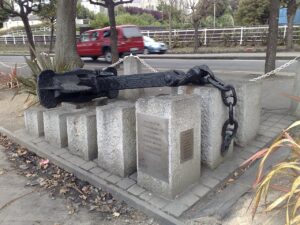 On October 18, 1918, at 9:10am U-125, outbound from Germany, picked up a radio message requesting advice on the best way to get through the North Sea minefield. The sender was U-123. Extra mines had been added to the minefield since U-123 had made her outward voyage from Germany. As U-125 had just come through the minefield, U-125 radioed back with a suggested route. U-123 acknowledged the message and was never heard from again. The following say, ten days after the sinking of the RMS Leinster, U-123 detonated a mine and sank while trying to cross the North Sea and return to base in Imperial Germany. There were no survivors. In 1991, the anchor of the RMS Leinster was raised by local divers. It was placed near Carlisle Pier and officially dedicated on January 28, 1996.
On October 18, 1918, at 9:10am U-125, outbound from Germany, picked up a radio message requesting advice on the best way to get through the North Sea minefield. The sender was U-123. Extra mines had been added to the minefield since U-123 had made her outward voyage from Germany. As U-125 had just come through the minefield, U-125 radioed back with a suggested route. U-123 acknowledged the message and was never heard from again. The following say, ten days after the sinking of the RMS Leinster, U-123 detonated a mine and sank while trying to cross the North Sea and return to base in Imperial Germany. There were no survivors. In 1991, the anchor of the RMS Leinster was raised by local divers. It was placed near Carlisle Pier and officially dedicated on January 28, 1996.
 It seemed like a simple matter of a choice. Juliane Margaret Beate Koepcke, who was born on October 10, 1954, was set to graduate in Lima, Peru on December 23, 1971, and she wanted to attend her graduation ceremony before flying home to Panguana with her mother, Maria Koepcke. Juliane the only child of German zoologists Maria (née von Mikulicz-Radecki; 1924–1971) Maria and Hans-Wilhelm Koepcke (1914–2000). Her parents were working at Lima’s Museum of Natural History when she was born. When Juliane was 14, the family left Lima to establish the Panguana research station in the Amazon rainforest, where she learned survival skills. Unfortunately, the educational authorities didn’t allow this type of “schooling” and she was required to return to the Deutsche Schule Lima Alexander von Humboldt to take her exams and graduate. Maria really wanted to leave on December 19th or 20th, but she finally agreed that her daughter could stay longer. So, they scheduled a flight for Christmas Eve. All the flights were booked except for one with LANSA, an airline that Juliane’s father, Hans-Wilhelm had urged his wife to avoid flying with due to its poor reputation. Disregarding the warning, Maria booked tickets on LANSA flight 508.
It seemed like a simple matter of a choice. Juliane Margaret Beate Koepcke, who was born on October 10, 1954, was set to graduate in Lima, Peru on December 23, 1971, and she wanted to attend her graduation ceremony before flying home to Panguana with her mother, Maria Koepcke. Juliane the only child of German zoologists Maria (née von Mikulicz-Radecki; 1924–1971) Maria and Hans-Wilhelm Koepcke (1914–2000). Her parents were working at Lima’s Museum of Natural History when she was born. When Juliane was 14, the family left Lima to establish the Panguana research station in the Amazon rainforest, where she learned survival skills. Unfortunately, the educational authorities didn’t allow this type of “schooling” and she was required to return to the Deutsche Schule Lima Alexander von Humboldt to take her exams and graduate. Maria really wanted to leave on December 19th or 20th, but she finally agreed that her daughter could stay longer. So, they scheduled a flight for Christmas Eve. All the flights were booked except for one with LANSA, an airline that Juliane’s father, Hans-Wilhelm had urged his wife to avoid flying with due to its poor reputation. Disregarding the warning, Maria booked tickets on LANSA flight 508.
Mid-way through the flight, the plane was struck by lightning. The plane actually began to disintegrate before plummeting to the ground. Suddenly, Juliane found herself, still strapped to her seat, falling 10,000 feet into the Amazon rainforest. Amazingly, she survived the fall, but she was injured. She suffered a broken collarbone, a deep cut on her right arm, an eye injury, and a concussion. Juliane then spent 11 days in the rainforest, most of which were spent making her way through water by following a creek to a river. Apparently, no one knew  that she was there, or that she was missing from the wreckage of the plane. The jungle is a very unforgiving place for those without some kind of protection, and Juliane found herself dealing with severe insect bites and an infestation of maggots in her wounded arm. I’m sure that she could not believe that after surviving a fall of 10,000 feet, she might die in the jungle from whatever animal or insect might attack her. Nine days into her ordeal, she came upon an encampment that had been set up by local fishermen. There, she was able to at least give herself basic first aid. It was crude, however, and included pouring gasoline on her arm to force the maggots out of the wound. Then, she waited. After a few hours, the returning fishermen found her, gave her proper first aid, and used a canoe to transport her to a more inhabited area. Finally, she was soon airlifted to a hospital.
that she was there, or that she was missing from the wreckage of the plane. The jungle is a very unforgiving place for those without some kind of protection, and Juliane found herself dealing with severe insect bites and an infestation of maggots in her wounded arm. I’m sure that she could not believe that after surviving a fall of 10,000 feet, she might die in the jungle from whatever animal or insect might attack her. Nine days into her ordeal, she came upon an encampment that had been set up by local fishermen. There, she was able to at least give herself basic first aid. It was crude, however, and included pouring gasoline on her arm to force the maggots out of the wound. Then, she waited. After a few hours, the returning fishermen found her, gave her proper first aid, and used a canoe to transport her to a more inhabited area. Finally, she was soon airlifted to a hospital.
Many experts have tried to speculate as to how Juliane could have possibly survived. Some said that she survived the fall because she was harnessed into her seat, the window seat, which was attached to the two seats to her left as part of a row of three. They thought that somehow that functioned as a sort of parachute which slowed her fall. Some thought that the impact may have also been lessened by the updraft from a thunderstorm Koepcke fell through, as well as the thick foliage at her landing site. Juliane wasn’t the only passenger to have survived the initial disaster. Approximately 14 other passengers were later discovered to have survived the initial crash, but sadly, all of those died while waiting to be rescued. After recovering from her injuries, Koepcke assisted search parties in locating the crash site and recovering the bodies of victims. Her mother’s body was discovered on January 12, 1972. Juliane says, “I had nightmares for a long time, for years, and of course the grief about my mother’s death and that of the other people came back again and again. The thought ‘why was I the only survivor?’ haunts me. It always will.”
Juliane returned to her parents’ native Germany, where she fully recovered from her physical injuries. Like her parents, she studied biology at the University of Kiel and graduated in 1980. She received a doctorate from Ludwig Maximilian University of Munich and returned to Peru to conduct research in mammalogy, specializing in bats. She published her thesis, “Ecological study of a bat colony in the tropical rain forest of Peru”, in 1987. In  1989, Koepcke married Erich Diller, a German entomologist who specializes in parasitic wasps. After her father died in 2000, she took over as the director of Panguana. Today, she serves as librarian at the Bavarian State Collection of Zoology in Munich. Juliane’s autobiography “Als ich vom Himmel fiel: Wie mir der Dschungel mein Leben zurückgab” (German for When I Fell from the Sky: How the Jungle Gave Me My Life Back) was released in 2011. The book won that year’s Corine Literature Prize. In 2019, the government of Peru made her a Grand Officer of the Order of Merit for Distinguished Services.
1989, Koepcke married Erich Diller, a German entomologist who specializes in parasitic wasps. After her father died in 2000, she took over as the director of Panguana. Today, she serves as librarian at the Bavarian State Collection of Zoology in Munich. Juliane’s autobiography “Als ich vom Himmel fiel: Wie mir der Dschungel mein Leben zurückgab” (German for When I Fell from the Sky: How the Jungle Gave Me My Life Back) was released in 2011. The book won that year’s Corine Literature Prize. In 2019, the government of Peru made her a Grand Officer of the Order of Merit for Distinguished Services.

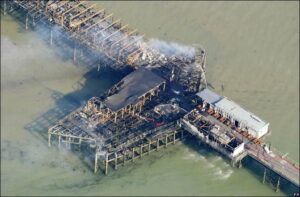 Southend Pier, is the longest pier in the world. It is located in Southend-On-Sea, Essex, United Kingdom. It is famous for being the longest pier, but it is also famous for something else. It has a long history of…fires!! It wasn’t that there were so many fires, but rather that they occurred over a long period…40 years to be exact. That might not sound like such a big deal, which while sounding like a long period of time, is still rather unusual. The fires on the pier took place in 1959, 1976, 1995, and 2005.
Southend Pier, is the longest pier in the world. It is located in Southend-On-Sea, Essex, United Kingdom. It is famous for being the longest pier, but it is also famous for something else. It has a long history of…fires!! It wasn’t that there were so many fires, but rather that they occurred over a long period…40 years to be exact. That might not sound like such a big deal, which while sounding like a long period of time, is still rather unusual. The fires on the pier took place in 1959, 1976, 1995, and 2005.
Originally, the pier was really no more than a timber jetty. Then in 1829, a was passed to build the new pier. The bill received Royal Assent in May 1829 and construction started in July 1829. The original wooden pier that was finished in 1830, was just 600 feet long and probably nothing that could be considered spectacular. Over the years, the pier has evolved into an iron construction over a mile and a third in length. The history of the pier dating back well over a century, was one of developing facilities and increasing use by holidaymakers, with the exception of the World War II years. From 1939 to 1945 the pier was designated HMS Leigh and used as a mustering point for convoys and the location of Thames Estuary naval control staff.
All was going well, and then on October 7, 1959, disaster struck. In the evening a fire began in the Victorian pavilion towards the shore end of the pier. That part of the pier, a wooden structure went up like dried grass. At the time, there were between 300 and 500 visitors who were at the far end of the pier more than a mile away from the pavilion. It was a scary situation, because the visitors were required to walk toward the flames and then descend into waiting boats to be ferried back to the shore, bypassing the blaze. Of course, like any such incident, onlookers were provided with more than two hours of free entertainment, and since the pier was a popular attraction, there was a large crowd on the shore.
Because the pier was such a popular attraction, it was quickly repaired, and the pavilion was replaced with a bowling alley. While everyone thought everything was looking up, it was the start of a remarkable run of 
 disasters. More fires followed in 1976, 1995, and 2005 wreaking havoc on the pier. In addition, the MV Kingsabbey, a converted waste disposal carrier with a history of accidents crashed into the Southend pier in June 1984, smashing a 70-foot hole in the pier. The damage caused by that crash was not fully repaired until 1989.
disasters. More fires followed in 1976, 1995, and 2005 wreaking havoc on the pier. In addition, the MV Kingsabbey, a converted waste disposal carrier with a history of accidents crashed into the Southend pier in June 1984, smashing a 70-foot hole in the pier. The damage caused by that crash was not fully repaired until 1989.
 I like watching football occasionally, but I’m no expert on the game. Over the years, I have learned more about it, but that doesn’t mean that I totally get it. Nevertheless, even I can see when something is completely lopsided, and I can see that something went terribly wrong with a football game that is completely lopsided. Recently, the Denver Broncos played such a game against the Miami Dolphins. Denver lost to Miami, 70 to 20. That is an almost unheard-of loss, and I wondered if the Broncos simply sat on the sidelines and watched the game go down the tubes. I hadn’t watched the game, even though the Broncos are my favorite team. Nevertheless, that game is nowhere near the worst game in history.
I like watching football occasionally, but I’m no expert on the game. Over the years, I have learned more about it, but that doesn’t mean that I totally get it. Nevertheless, even I can see when something is completely lopsided, and I can see that something went terribly wrong with a football game that is completely lopsided. Recently, the Denver Broncos played such a game against the Miami Dolphins. Denver lost to Miami, 70 to 20. That is an almost unheard-of loss, and I wondered if the Broncos simply sat on the sidelines and watched the game go down the tubes. I hadn’t watched the game, even though the Broncos are my favorite team. Nevertheless, that game is nowhere near the worst game in history.
On October 7, 1916, Georgia Tech defeated Cumberland University in a scorchingly lopsided loss of 222 to 0. Of course, these were not professional football players, who would be expected to have better scoring ability, but 222-0 indicates that one team must have stayed in the locker room. The Georgia Tech team was coached by John Heisman, who was later the namesake of college football’s most famous trophy. Georgia Tech took an early 63-0 lead in the first quarter at Grant Field in Atlanta. And they managed to completely shut out every play Cumberland tried to execute. As the Atlanta Constitution reported, “All of Cumberland’s plays were smothered completely.” That was putting it mildly. Ed Haysler Poague, who played for Cumberland, recalled decades later, “I think one of our best plays of the game was when one of our players got the ball on a pitchout and he lost only 10 yards.” 
By halftime, the game was “for all intents and purposes” over. Nevertheless, despite a 126-0 halftime lead, Heisman decided to take his team to greatness, so he urged them to keep the pressure on, telling them, “You never know what those Cumberland players have up their sleeve, so in the second half, go out and hit ’em clean and hit ’em hard. Do not let up.” Heisman agreed to shorten the quarters to 12 minutes from 15. There was speculation that he ran up the score because he thought Cumberland, a team out of Lebanon, Tennessee, used professional players to beat Georgia Tech in baseball. Heisman also coached baseball, so that could have been a source of contention, whether it was true or not.
Coach Poage said of his team, “We really didn’t have such a bad team. We were just so ridiculously outclassed that day that it was, well, ridiculous.” The reality is that any team can have a bad day, or even a bad season, but Cumberland just couldn’t catch a break, and after a while, they couldn’t concentrate on what they were doing. It’s common for a coach to tell his team to “keep their head in the game.” That advise doesn’t always do much good, and this time was no exception. By halftime, and trailing 126 to 0, Cumberland couldn’t even see daylight from the hole they were in, much less “keep their head in the game” that they were being slaughtered in.
As for the Georgia Tech fans, well it seems that they thought the Cumberland team might be tough to beat, but before long, they knew better. Coach Poague recalled, “But it didn’t take them long to realize that it wasn’t going to be too difficult. They did a lot of laughing after that.” I’m sure that no one on the Cumberland team  was laughing, during the game or for many months after it. A loss like that is really hard to live down. In reality, Cumberland had discontinued football before the 1916 season, but forgot to tell Coach Heisman, who insisted that the game be played, or face a $3000 forfeit fee, which was a lot of money back then. Cumberland was forced to round up 13 students, many of them fraternity brothers, to go to Atlanta and play. So in their defense, these “football players” were really no such thing, and it was a seriously lopsided game even before it started. Heisman, who had been beaten by Cumberland in a 1915 baseball game, 22 to 0, wanted to have his revenge, so he told his team to keep up the beating, which they did…not that it was really a fair fight.
was laughing, during the game or for many months after it. A loss like that is really hard to live down. In reality, Cumberland had discontinued football before the 1916 season, but forgot to tell Coach Heisman, who insisted that the game be played, or face a $3000 forfeit fee, which was a lot of money back then. Cumberland was forced to round up 13 students, many of them fraternity brothers, to go to Atlanta and play. So in their defense, these “football players” were really no such thing, and it was a seriously lopsided game even before it started. Heisman, who had been beaten by Cumberland in a 1915 baseball game, 22 to 0, wanted to have his revenge, so he told his team to keep up the beating, which they did…not that it was really a fair fight.
 What could make a nation go through an earthquake and refuse help from another nation, like the United States? It seems like a strange question, but it is valid. On October 6, 1948, a magnitude 7.3 earthquake leveled Ashgabat, the capital of the Turkmen Soviet Socialist Republic—now Turkmenistan. The quake killed between 70,000 and 100,000 people. The true number will never be known. In fact, most information of the scope of the disaster remained unknown outside Central Asia until 1973, when archival records were finally unsealed by local officials. So…why seal the records…of an earthquake??
What could make a nation go through an earthquake and refuse help from another nation, like the United States? It seems like a strange question, but it is valid. On October 6, 1948, a magnitude 7.3 earthquake leveled Ashgabat, the capital of the Turkmen Soviet Socialist Republic—now Turkmenistan. The quake killed between 70,000 and 100,000 people. The true number will never be known. In fact, most information of the scope of the disaster remained unknown outside Central Asia until 1973, when archival records were finally unsealed by local officials. So…why seal the records…of an earthquake??
The town of Ashgabat lies at the foot of the Kopet-Dag Mountain range near the border with Iran. The area is geologically unstable and earthquake prone. That said, why should a large earthquake in an earthquake-prone area need to be hidden? Ashgabat was originally a czarist outpost, founded in 1881. The town grew quickly during World War II, due to evacuees from the war zone. The population grew to an estimated 150,000 people. With a huge influx of people came the need for a lot of new housing, so single-story houses of unreinforced brick and stone, with heavy roofs of packed clay were quickly built, without regard for the need for earthquake proofing. I suppose that was the reason that the authorities didn’t want anyone to come in to help or to know the details of the catastrophe or the number of victims. The schools, hospitals, and other public buildings were built in the same shoddy way. It was wartime, so it may have been that supplies were scarce, or that proper time was not spent on the construction. Of course, less was known about how earthquakes affect buildings too, and even though there were existing seismic standards, they were seldom met. The builders greatly underestimated the earthquake danger, and that was a fact. A 1929 quake had already caused significant property damage, but strangely, the fault zone had been unusually inactive. I suppose this could have been a warning sign. When it is overdue, it may be a sign of an impending catastrophe.
In this case, that was exactly what happened. On October 6, 1948, at 1:17am, with few people awake. Suddenly, they an ominous rumbling from the mountains, followed immediately by violent vertical shaking. It was actually two strong shocks seconds apart, and just as suddenly, Ashgabat was reduced to rubble. There was no escape…there was no time for escape. The buildings were standing one second and collapsed the next. The thing that is the most shocking was that many of the survivors, who had been conditioned by propaganda in the acute early phase of the Cold War, thought that the city had been hit by an American atomic bomb. And the government did nothing to correct their misguided thinking. So, the country did not seek help from the United States.
As suddenly as it had occurred, the quake severed all communications with the outside world. There were no emergency centers, because hospitals, clinics, and pharmacies lay in ruins. The few remaining uninjured rescue workers, members of the city’s emergency services struggled in the darkness to help the injured. Doctors, many of whom had served in the war, pulled equipment from the ruins to set up an emergency station in Karl Marx Square. Finally, by the afternoon, reinforcements and supplies began to arrive from Tashkent and Baku. Nevertheless, the number of casualties, and the inherent difficulty of evacuating gravely wounded people, meant that help came too late for many. It was estimated that half of an estimated thirty thousand people who  had life-threatening injuries died from lack of early treatment…many people died before they could even be pulled from the rubble.
had life-threatening injuries died from lack of early treatment…many people died before they could even be pulled from the rubble.
While the city workers immediately ran to the damaged central headquarters of the Communist Party, where they were told by the party’s first secretary, S Batirova to take an undamaged automobile and head northward to a functioning telephone line, and soldiers stationed at the airport used an aircraft radio to contact Baku and Sverdlovsk, it was still many hours before any details reached areas from which aid could be dispatched.Unfortunately, that wasn’t much help either, because the railway station was in ruins, tracks were blocked, the airport control tower was destroyed, and the airport and roads could not handle heavy traffic. It would take hours and even days, to get the much-needed rescue support the city needed.
Of course, because of the misguided concept that the Americans were somehow involved, the precise death toll will never be known for sure. Estimates range from a shockingly low number of 400, suggested by Nature magazine in 1948, to a more likely number of 110,000. The dead were buried in mass graves. They were not counted or identified, adding to the confusion. There were roughly 50,000 survivors in a city that had previously had a population of approximately 150,000. That suggests that a death toll of 80,000 to 100,000, or about two-thirds of the population is a more accurate number.
The death toll was enormous, and that could have also accounted for the lack of emergency workers. It’s highly likely that many of them were among the dead or injured…not to mention the fact that there may have been a gross shortage of qualified rescue workers in the poorest part of a country, which was just still recovering from long years of war, but the poor response from the rest of the Soviet Union became more and more unconscionable. On October 7, Pravda printed a brief article stating only that “geologists at the Russian Academy of Sciences had detected a strong earthquake.” The article also reported that there were supply shipments and of the evacuation of the wounded, but no mention of the scope of devastation or the number of casualties. Of course, the international press used Pravda’s limited and incorrect reportage about the quake as the source for their own news reports.
To make matters worse, a conspiracy of silence followed the destruction of Ashgabat. Most history books and almanacs of natural disasters actually omit the quake entirely!! In the typical Soviet propaganda style of the 1950’s, they actually praised the severely lacking reconstruction efforts that completely ignored seismological standards. One Soviet journalist who visited the city in 1953, later described being “forbidden to photograph the omnipresent ruins or to report a march of weeping survivors to the mass graves on the outskirts of the city.” Little was known about the devastating earthquake until 1973. Only on the twenty-fifth anniversary of the event, did officials in Turkmenistan begin to open sealed archives and acknowledge the terrible calamity. Why was this? It was largely because of the Cold War, when both sides were eager not to expose their strategic vulnerabilities. That still doesn’t make sense, however, because the destruction of Ashgabat neither compromised the Soviet Union’s defense system nor revealed grave internal weaknesses. The forced silence did nothing to improve domestic morale in Russia, and it created widespread resentment in Central Asia. 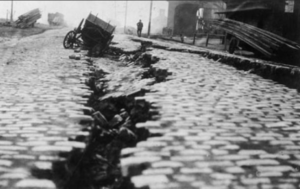 Internationally the Soviet Union could have gained propaganda points by publicizing the disaster and then criticizing the lack of response from the West, but for some reason, they didn’t so that either. Of course, the people in the Soviet Union lived in fear of Joseph Stalins sweeping purges and force silence and timidity. They didn’t dare speak of any kind of vulnerability. Until Stalin’s death in 1953, even referencing the event was considered a dangerous move. Financial aid was still desperately needed decades after the disaster, yet it still didn’t really come. Silence translated into slow reconstruction. Substantial portions of the city remain in ruins, and a significant portion of the population still lives in temporary, or inadequate and unsafe, dwellings to this day.
Internationally the Soviet Union could have gained propaganda points by publicizing the disaster and then criticizing the lack of response from the West, but for some reason, they didn’t so that either. Of course, the people in the Soviet Union lived in fear of Joseph Stalins sweeping purges and force silence and timidity. They didn’t dare speak of any kind of vulnerability. Until Stalin’s death in 1953, even referencing the event was considered a dangerous move. Financial aid was still desperately needed decades after the disaster, yet it still didn’t really come. Silence translated into slow reconstruction. Substantial portions of the city remain in ruins, and a significant portion of the population still lives in temporary, or inadequate and unsafe, dwellings to this day.

 The loss of a loved one is one of the hardest of life events, and when it is a child, be it a young child or an adult child, it is even worse. For my uncle, Lester “Jim” Wolfe and my aunt, Ruth Wolfe, the loss of their adult son, Larry Wolfe in an explosion on May 16, 1976, was a devastation. They, like any parent, had a really hard time coping with the loss. They were living in Vallejo, California at the time, but after their loss, they could no longer stay there. They had to get out of California. It was then that a move to Washington state seemed their best option. I don’t know if Washington had been on their radar prior to Larry’s passing at 26 years old, or not, but they moved the entire family to the mountains outside Newport, in eastern Washington state. They purchased basically the entire mountain top, and built three cabins, where they would live out their lives.
The loss of a loved one is one of the hardest of life events, and when it is a child, be it a young child or an adult child, it is even worse. For my uncle, Lester “Jim” Wolfe and my aunt, Ruth Wolfe, the loss of their adult son, Larry Wolfe in an explosion on May 16, 1976, was a devastation. They, like any parent, had a really hard time coping with the loss. They were living in Vallejo, California at the time, but after their loss, they could no longer stay there. They had to get out of California. It was then that a move to Washington state seemed their best option. I don’t know if Washington had been on their radar prior to Larry’s passing at 26 years old, or not, but they moved the entire family to the mountains outside Newport, in eastern Washington state. They purchased basically the entire mountain top, and built three cabins, where they would live out their lives.
They lived a good life on the mountain top. They were completely off the grid, something that is common these  days, but not so much back then. Nevertheless, they craved total isolation, and the mountain top provided just that. Still, while they wanted to be left alone, they still enjoyed traveling, and they came out to see our family several times after that. Aunt Ruth was my dad, Allen Spencer’s sister, after all. Uncle Jim lost Aunt Ruth to cancer, on May 11, 1992, when she was just 66 years old. I’m sure he quickly learned to dread the coming of May. After that, we lost touch with them unto shortly before Uncle Jim passed away on January 30, 2013. We had reconnected with his daughter, my cousin Shirley Cameron in 2011, but by that time Uncle Jim was already in a nursing home with Dementia. We were always sad about that, but for the most part Uncle Jim was happy. His favorite things to do were strolling down the halls in his wheelchair singing and flirting with the nurses that worked there. They all loved him and thought his flirting was cute, and knowing my uncle like I did, I’m sure he was also a great jokester. He always had been, so playing pranks on the nurses came naturally. He once tried hiding in the nurses’ station but got caught. I’m not sure if his plan was to scare them or to catch one around the waist when she wasn’t looking. I wouldn’t put either choice past him. Uncle Jim was always a lighthearted person and great fun to be around. He loved to take his family camping, and maybe that was a big part of the reason the family moved to the mountains of Washington in the first place.
days, but not so much back then. Nevertheless, they craved total isolation, and the mountain top provided just that. Still, while they wanted to be left alone, they still enjoyed traveling, and they came out to see our family several times after that. Aunt Ruth was my dad, Allen Spencer’s sister, after all. Uncle Jim lost Aunt Ruth to cancer, on May 11, 1992, when she was just 66 years old. I’m sure he quickly learned to dread the coming of May. After that, we lost touch with them unto shortly before Uncle Jim passed away on January 30, 2013. We had reconnected with his daughter, my cousin Shirley Cameron in 2011, but by that time Uncle Jim was already in a nursing home with Dementia. We were always sad about that, but for the most part Uncle Jim was happy. His favorite things to do were strolling down the halls in his wheelchair singing and flirting with the nurses that worked there. They all loved him and thought his flirting was cute, and knowing my uncle like I did, I’m sure he was also a great jokester. He always had been, so playing pranks on the nurses came naturally. He once tried hiding in the nurses’ station but got caught. I’m not sure if his plan was to scare them or to catch one around the waist when she wasn’t looking. I wouldn’t put either choice past him. Uncle Jim was always a lighthearted person and great fun to be around. He loved to take his family camping, and maybe that was a big part of the reason the family moved to the mountains of Washington in the first place.
It was with heavy hearts that we attended the funeral of our uncle. My mom, Collene Spencer, sister, Cheryl 
 Masterson, and I all made the trip to Washington. It was a bittersweet trip. We were happy to see their family again. We had not seen my cousin, Terry Wolfe, Shirley’s brother in many years either, although we had texted back and forth a little. We just wished that the reason for the trip had not been my Uncle Jim’s funeral. While it would have been hard, we would much rather have been able to visit him at the nursing home just once before his passing. Today would have been Uncle Jim’s 102nd birthday had he still been with us. Happy birthday in Heaven, Uncle Jim. We love and miss you very much.
Masterson, and I all made the trip to Washington. It was a bittersweet trip. We were happy to see their family again. We had not seen my cousin, Terry Wolfe, Shirley’s brother in many years either, although we had texted back and forth a little. We just wished that the reason for the trip had not been my Uncle Jim’s funeral. While it would have been hard, we would much rather have been able to visit him at the nursing home just once before his passing. Today would have been Uncle Jim’s 102nd birthday had he still been with us. Happy birthday in Heaven, Uncle Jim. We love and miss you very much.

